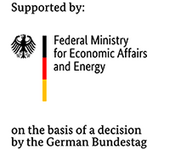The goal of the “Virtual Crater” project is to develop a virtual test environment (virtual testbed) where it is possible to program, test, and optimize robot systems in a realistically simulated lunar crater in a cost-effective way. An important aspect in this project is the comparison between the planned virtual testbed and the real lunar test environment (real testbed) that is to be built in DFKI through the LUNARES project (DLR Fkz: 50 RA 0706). In this project, the German Research Center for Artificial Intelligence (DFKI GmbH) is cooperating in a partnership with Dortmunder Initiative zur rechnerintegrierten Fertigung (RIF) e.V.
The Virtual Crater is a comprehensive simulation environment that makes it possible to program and test missions of lunar surface exploration and to demonstrate new concepts. In order to make this testbed behave as close to reality as possible, various parameters and processes need to be identified precisely and turned into versatile simulation components. In order to do this, a comprehensive set of physical experiments will be performed and will be compared to the analogous simulated experiments. These experiments are labelled reference experiments. The simulation can then in turn – and in combination with specialized optimization tools – be used as an elaborate basis to perform optimizations of the hardware, scenario setup and evaluation of contingency cases. Figure 1 shows the real and virtual testbeds; in particular, it shows the integration of the robot controller in the real and virtual testbeds. One important goal in this work is to develop a method in which a robot controller can run in the virtual testbed as well as in the real testbed without any readjustments so that the virtual robot can be programmed and controlled the same way as the real one. In addition, it allows the users to immerse themselves completely in the virtual world as the “Virtual Crater” simulation system will be applied to projection-based visualization systems (CAVE System) as well as normal PCs.
In order to achieve our goal, we use an effective tool-chain (Fig. 2) to optimize system parameters by precisely modelling and simulating the given lunar scenarios close to real time. Emphasis has been laid on real-time capabilities to intuitively support the system constructions and on elaborate soil contact models and the identification of the respective parameters of regolith. In practice, it can e.g. be shown that a mathematical model derived from the physical actuator with the help of Adams/Matlab, and then simplified as a numerical model can be used in the real-time simulation VEROSIM.
Partners
Dortmunder Initiative zur rechnerintegrierten Fertigung (RIF) e.V.

